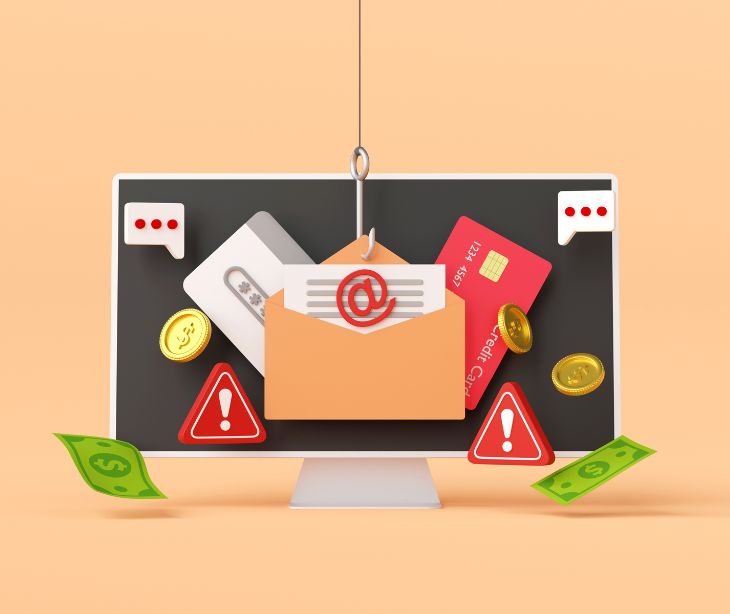
Impersonation attacks are targeted phishing attempts that involve impersonating individuals or entities through social engineering. The aim is to trick employees into sharing confidential data and transferring funds or login credentials, enabling cybercriminals to carry out unauthorized activities.
Types of impersonation attacks
Impersonation attacks can manifest in various forms, each with its own unique characteristics and methods of execution. Familiarizing yourself and your employees with the most common impersonation attacks can enhance your organization's resilience against these threats.
Email impersonation attacks
Cybercriminals often masquerade as coworkers, managers, or high-ranking executives using fake or stolen email accounts. Unlike mass email phishing attacks that typically end up in spam folders, these spear phishing attacks are highly targeted and sophisticated.
Read also: What is a phishing attack?
Cousin domain impersonation
Cousin domain impersonation attacks involve the creation of false company websites or emails that closely resemble official organization channels. Attackers manipulate domain codes to create deceptive emails or websites that mimic legitimate ones. Utilizing incorrect domain codes, deceives recipients into believing that the communication is genuine.
Forged header impersonation
Forged header, envelope impersonation, or email spoofing, involves using fake headers or sender addresses to make an email appear legitimate. Cybercriminals modify the "sender" field in an email header or envelope, changing the "From:" or "Return-Path:" title fields to mimic a trusted source.
Account takeover
Account takeover attacks, also called compromised email account attacks, involve cybercriminals gaining unauthorized access to an individual's account using stolen credentials. These credentials are often acquired through data breaches, data leaks, or brute-force attacks.
Once the attacker successfully logs into the compromised account, they can carry out various malicious activities, including sending phishing emails to contacts within the compromised email list. This makes it challenging for victims to detect the impersonation attempts.
Man-in-the-Middle (MITM) Attack
Man-in-the-middle (MITM) attacks involve cybercriminals intercepting communications between individuals, applications, or services. Exploiting vulnerabilities in HTTPS connections, SSL/TLS connections, or unsafe Wi-Fi networks intercepts and modifies messages, potentially gaining access to sensitive information.
Read more: What is a man-in-the-middle (MITM) attack?
Smishing and Vishing
Smishing, or SMS phishing, involves phishing attacks through SMS text messages. Attackers send text messages containing malicious links that can infect a target's mobile device with viruses, spyware, or adware. These messages may also impersonate personal or professional contacts, misleading victims into believing the text's legitimacy.
Vishing, or voice phishing, occurs during phone calls when attackers impersonate important parties, such as government agencies or businesses. They may personally make the phone call or use automated systems to conduct fraudulent calls. To protect yourself, it is best to ignore unknown numbers and refrain from agreeing to any requests over the phone.
Related: What is vishing?
How to stay protected against impersonation attacks
It is important to focus on early detection and cybersecurity education to safeguard your organization from impersonation attacks and phishing scams.
Security awareness training
Organizations should conduct regular training and education programs to inform employees about various cyber threats, including impersonation attacks. Security awareness training should also cover best security practices, such as creating secure passwords, recognizing scam attempts, and browsing the internet safely.
Using custom email domains
Consider creating custom email domains for your business instead of relying on common email service providers like Gmail or Yahoo. Custom domains provide more oversight and control over email data, allowing for better management of user permissions.
Implementing email security solutions
Deploying email security tools, such as anti-malware and anti-spam software, can help protect employees from fraudulent emails. These tools can block potentially dangerous emails, links, and attachments, preventing users from inadvertently exposing themselves to risks.
AI-driven and automated software
Many organizations leverage automated software and proactive threat intelligence to scan emails and detect potential impersonation attacks before they reach users' inboxes. These solutions cross-reference email contents with registered phishing scripts to identify suspicious activities.
Reporting impersonation attacks
Encourage all employees to report impersonation attacks to the IT department if they suspect they or their colleagues have been targeted. Establish clear reporting protocols and define immediate action steps to identify and promptly eliminate potential impersonation attack risks.
Read also: Brand impersonation in healthcare
In the news
In recent cyberattacks targeting organizations like MGM Resorts and Caesars Entertainment, threat actors used sophisticated methods to execute impersonation attacks via Okta's IAM platform. Exploiting vulnerabilities in Okta's architecture, attackers engaged in cross-tenant impersonation, manipulating authentication flows and possibly compromising super administrator accounts to bypass MFA and gain unauthorized access across different tenants.
They also employed anonymizing proxies to obscure their identities, manipulated usernames for seamless single sign-on into main applications, and configured secondary identity providers to further mask their activities. These tactics prove the sophistication of impersonation attacks, indicating the need for organizations to bolster their IAM security measures and vigilance against such targeted threats.
FAQs
What is an impersonation attack and how does it relate to healthcare security?
An impersonation attack is a type of cyberattack where an attacker pretends to be a trusted individual, such as a healthcare provider or patient, to gain unauthorized access to sensitive information or systems. In healthcare, these attacks can compromise patient data, disrupt services, and lead to big security breaches.
Why are impersonation attacks a significant threat to healthcare organizations?
Impersonation attacks are big threats because they exploit trust relationships within healthcare organizations. Attackers can use impersonation to gain access to medical records, financial information, or main systems, leading to data breaches, financial loss, and harm to patient care and trust.
What measures can healthcare facilities take to prevent impersonation attacks?
Healthcare facilities can prevent impersonation attacks by implementing strong authentication methods, such as multi-factor authentication (MFA), educating staff about the risks and signs of impersonation attempts, using advanced email security solutions to detect phishing, and establishing strict verification procedures for sensitive transactions and communications.
How do impersonation attacks impact HIPAA compliance?
Impersonation attacks impact HIPAA compliance by increasing the risk of unauthorized access to protected health information (PHI). Successful impersonation attacks can lead to data breaches, which violate HIPAA’s requirements for safeguarding PHI and can result in major penalties and reputational damage.
Subscribe to Paubox Weekly
Every Friday we'll bring you the most important news from Paubox. Our aim is to make you smarter, faster.




